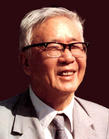

Hua Loo Keng (1910.11-1985.06) was a native of Jintan, Jiangsu province. He was a world-renowned Chinese mathematician. Hua did not receive a formal university education. Although awarded several honorary PhDs, he never got a formal degree from any university. He was the first Chair of the Department of Mathematics and Vice President of University of Science & Technology of China (USTC), a new type of Chinese university established by the Chinese Academy of Sciences (CAS) in 1958, which was aimed at fostering skilled researchers necessary for the economic development, defense and education in science and technology. In 1979 he was a visiting research fellow of the then Science Research Council of the United Kingdom at the University of Birmingham and during 1983-84 he was Sherman Fairchild Distinguished Scholar at the California Institute of Technology. Hua received honorary doctorates from the University of Nancy (1980), the Chinese University of Hong-Kong (1983), and the University of Illinois (1984). He was elected a foreign associate of the National Academy of Sciences (1982) and a member of the Deutsche Akademie der Naturforscher Leopoldina (1983), Academy of the Third World (1983), and the Bavarian Academy of Sciences (1985).
He was the founder and pioneer in many fields in mathematical research. In as early as 1940s, Hua got the best estimation of trigonometric sums of general polynomial, which was a generalization of Gaussian sum and its estimation. Hua proved an integral mean inequality of trigonometric sums, or so called Hua's Inequality, which could prove Hardy and Littlewood's improvement to Waring's problem. Hua had also applied a principle technique to enhance the result one British mathematician obtained on Tully Problem.
Hua developed, with Wang Yuan, a broad interest in linear programming, operations research, and multidimensional numerical integration. In connection with the last of these, the study of the Monte Carlo method and the role of uniform distribution led them to invent an alternative deterministic method based on ideas from algebraic number theory. Their theory was set out in Applications of Number Theory to Numerical Analysis, which was published in 1978 and by Springer in English translation in 1981. The newfound interest in applicable mathematics took him in the 1960s, accompanied by a team of assistants, all over China to show workers of all kinds how to apply their reasoning faculty to the solution of shop-floor and everyday problems.
He wrote more than 200 papers and monographs, many of which became classics. His book on additive prime number theory influenced many subsequent number theorists in China, including the renowned Chen Jingrun who obtained the best result so far towards the binary Goldbach conjecture. His research described in his monograph "Harmonic Analysis on classic domain in theory of analytic functions of several variables" won State Natural Sciences Award, First Class. His books titled as "On Optimization Method" and "On Overall Planning Method" were both well underdtood by working class and helped in maximizing economic returns.
APPLICATION OF NUMBER THEORY TO APPROXIMATION ANALYSIS
Hua Loo Keng and Wang Yuan
(Institute of Mathematics, Chinese Academy of Sciences)
Abstract
The basic idea of Monte Carlo method is to replace an analytic problem by a probabilistic problem with the same solution and then investigate the later problem by statistical simulation. Hence we need a set of so called random numbers in Monte Carlo method. The basic idea of number -theoretic method is to construct by number theory a set of points which is uniformly scattered in a given domain such as rectangle, ball, sphere or simplex. This set of points is called quasi-random numbers which may be used instead of random numbers in statistical simulation, and it often leads to more precise results than Monte Carlo method in many known cases such as multiple quadratures. The authors proposed a method in 1959-1964 to construct quasi-random numbers by the use of algebraic number theory and Diophantine approximations. This method has advantages compared with the known number-theoretic method, in particular, when the dimension of domain for simulation is high or the number of points is large. This method is usually called the Hua-Wang method.